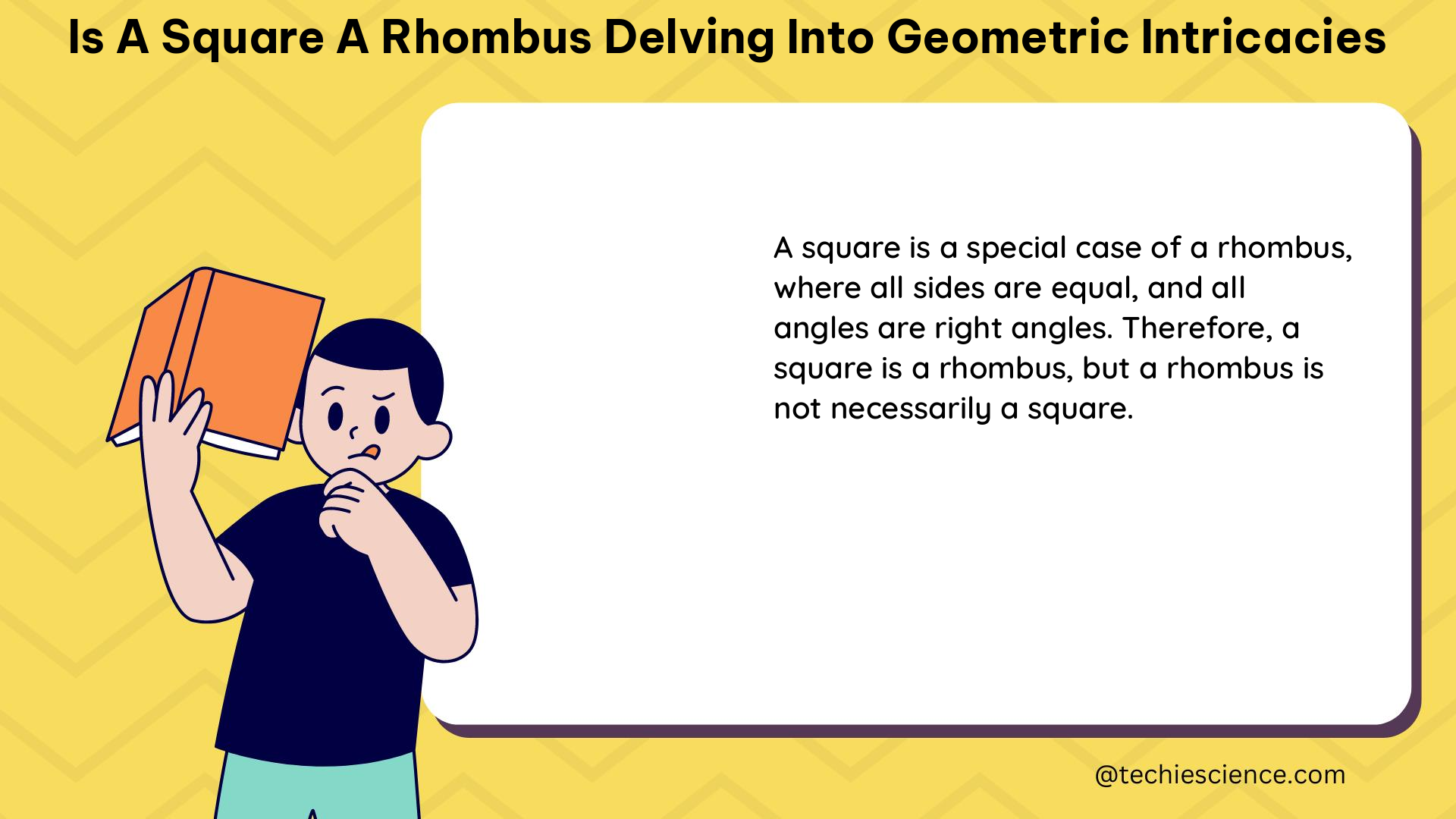A square is indeed a special type of rhombus, a quadrilateral with all sides of equal length. The unique property of a square that sets it apart from other rhombi is that all of its angles are right angles (90 degrees). This means that a square is also a rectangle, a quadrilateral with all angles being right angles.
Understanding the Geometric Properties of a Square
To delve into the geometric intricacies of a square being a rhombus, let’s explore the quantifiable data and technical specifications:
Sides
- A square has four sides, all of which are equal in length.
- This length is denoted as ‘a’ units.
Angles
- A square has four angles, all of which are right angles (90 degrees).
- The sum of the interior angles of a square is 360 degrees.
Diagonals
- A square has two diagonals, which are equal in length and bisect each other at right angles.
- The length of each diagonal can be calculated using the Pythagorean theorem: Diagonal = √(2 * a²), where ‘a’ is the length of a side.
- The diagonals of a square are perpendicular to each other and bisect each other at right angles.
Area
- The area of a square can be calculated by squaring the length of a side: Area = a² units.
Perimeter
- The perimeter of a square can be calculated by multiplying the length of a side by four: Perimeter = 4 * a units.
Geometric Theorems and Formulas

To further understand the geometric intricacies of a square, let’s explore some relevant theorems and formulas:
-
Pythagorean Theorem: In a right-angled triangle, the square of the length of the hypotenuse (the longest side) is equal to the sum of the squares of the lengths of the other two sides. This theorem is used to calculate the length of the diagonals in a square.
-
Quadrilateral Theorem: A quadrilateral is a square if and only if all its sides are equal, and all its angles are right angles (90 degrees).
-
Rhombus Theorem: A rhombus is a quadrilateral with all sides of equal length. A square is a special case of a rhombus, where all angles are also right angles.
-
Area of a Square: The area of a square is calculated by squaring the length of one of its sides: Area = a².
-
Perimeter of a Square: The perimeter of a square is calculated by multiplying the length of one of its sides by four: Perimeter = 4 * a.
Numerical Examples and Applications
To further illustrate the geometric intricacies of a square, let’s consider some numerical examples and applications:
- Example 1: If the length of a side of a square is 5 units, calculate the following:
- Diagonal length: Diagonal = √(2 * 5²) = √50 ≈ 7.07 units
- Area: Area = 5² = 25 square units
-
Perimeter: Perimeter = 4 * 5 = 20 units
-
Example 2: A square tile has a side length of 0.5 meters. Calculate the total area covered by 25 such tiles arranged in a 5 x 5 grid.
- Area of one tile: 0.5 m × 0.5 m = 0.25 m²
-
Total area covered: 25 tiles × 0.25 m² = 6.25 m²
-
Application: Squares are commonly used in architectural and engineering designs, such as floor tiles, window panes, and building foundations. The geometric properties of squares, such as their equal sides and right angles, make them structurally stable and visually appealing.
Conclusion
In conclusion, a square is a special type of rhombus with unique geometric properties that make it an interesting and versatile shape. By understanding the technical specifications, theorems, and applications of squares, we can appreciate the intricacies of this fundamental geometric figure and its importance in various fields of study and practical applications.
References
- Determining if a set of points is a rhombus, square or rectangle
- 26th ICMI Study Proceedings – International Mathematical Union
- words.h
- Square – Trinket
- packages-bytestring/tests/Usr.Dict.Words at master – GitHub

The lambdageeks.com Core SME Team is a group of experienced subject matter experts from diverse scientific and technical fields including Physics, Chemistry, Technology,Electronics & Electrical Engineering, Automotive, Mechanical Engineering. Our team collaborates to create high-quality, well-researched articles on a wide range of science and technology topics for the lambdageeks.com website.
All Our Senior SME are having more than 7 Years of experience in the respective fields . They are either Working Industry Professionals or assocaited With different Universities. Refer Our Authors Page to get to know About our Core SMEs.